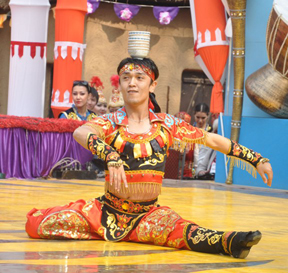 SURAJKUND, Haryana: The ongoing 28th Surajkund International Crafts Mela in Haryana’s Faridabad district has given a new life to the fading crafts, besides drawing a large number of visitors who throng the fair to bag the best of handicrafts and handlooms, and watch vibrant cultural performances on the Chaupal.
SURAJKUND, Haryana: The ongoing 28th Surajkund International Crafts Mela in Haryana’s Faridabad district has given a new life to the fading crafts, besides drawing a large number of visitors who throng the fair to bag the best of handicrafts and handlooms, and watch vibrant cultural performances on the Chaupal.
The footfall in the 15-day fair, which began on February 1, has so far touched nearly 4 lakh, including about 40,000 foreign visitors.
What makes the fair stand out is that it offers an enlightening interface between the visitors and the practitioners of fading crafts.
For instance, the name Ganjappa Cards may sound intriguing, but it’s a fading game from Odisha played among four persons.
Giving details about this, Banomali Mohapatra, an artiste from Odisha who practices this craft, says “these are playing cards made of cotton cloth and painted with stone-base natural colors. These are played according to color sequences.”
Brajbandhu Moharana, another artiste from Odisha, practices a languishing craft of making wooden painted toys that are figurines of animals and birds. “These are handmade and painted with precision. We make wall hangings that find good response at this Mela,” he says.
Another artist Bansidhar Mohrana narrates the process of making cow dung toys and masks, which are rare these days.
“Their base is made of cow dung and then using tamarind seeds, paper and stone powder, it is made firm and then painted with natural colors. People get inquisitive to know about this craft and end up buying a few pieces,” he says.
Warli painting of Maharasthra in its original avatar has come to Mela with artist Naresh Shankar Bhoyen demonstrating the art. “This art was earlier practiced to beautify home walls. Then it got translated on cloth, we first give it a thin cow dung base and make intricate tribal designs with rice paste, but now we use white color, as it lasts longer. It takes days together and lots of patience to make one piece,” he says.
Aranmula Mirror Art from Kerala is also an eye-catching one. P Gopa Kumar, master craftsman at the Mela, says, “We cast looking mirrors of different shapes and sizes in a mould made from bronze.”
Hemolata Devi, an artisan from Manipur, is busy doing an elegant and rare kind of embroidery known as Saphee Lanpheei on shawls and kurtis.
Another art form, Madhubani painting of Bihar is spreading its hue in the Mela.
Giving information about this pattern of art, Neeraj Kumar Jha, a stallkeeper said that this art form is about 50 years old and was traditionally done by the women of villages around the present town of Madhubani and Darbhanga and other areas of Mithila.
“It was done on freshly plastered mud walls and floors of huts, but now they are also done on cloth, T-Shirt, handmade paper and canvas. These paintings are made from the paste of rice powder,” he said, adding that these paintings are done with fingers, twigs, brushes, nib-pens, and matchsticks, using natural dyes and pigments, and are characterized by eye-catching geometrical patterns.
Jha said he has depicted scenes from Mahabharta, Ramayana and natural sceneries in his paintings which were being highly appreciated by the visitors, especially those from abroad.
The Mela, being held on the outskirts of Delhi, has Goa as its theme state this year and Sri Lanka as partner country.
Products of Sri Lanka displayed in the Mela depict an incredibly rich philosophy of the country’s civilization, its culture and its practices.
One such unique example of manual dexterity of Sri Lankan handlooms is Batik clothes showcased in the Mela. -PTI






